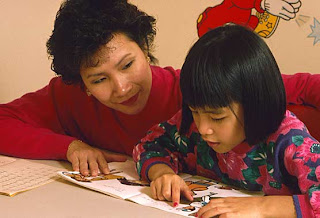What is attachment? Attachment is "a close emotional relationship between two persons, characterized by mutual affection and a desire to maintain proximity." (Bowlby, 1969) Attachment is reciprocal, enduring emotional tie between child and caregiver.
 |
| (modernmom.com) |
 |
| (blingcheese.com) |
- Experimenter introduces parent and baby to playroom and leaves
- Parent sits while baby plays
- Stranger enters, sits, and talks to parent
- Parent leaves, stranger offers comfort if the baby is upset
- Parent returns, greets baby, and offers comfort if baby is upset; stranger leaves
- Parent leaves the room
- Stranger enters and offers comfort
- Parent returns, greets baby, offers comfort if necessary, and tries to interest baby in toy
- Secure attachment (60 – 65% of 1 yr. old American infants): an infant/caregiver bond in which the child welcomes contact with a close companion and uses this person as a secure base from which to explore the environment (infant often greets mother warmly when she returns, if the infant is highly stressed he will seek physical contact with her)
- Achieved by sensitive, responsive caregivers from the very beginning. Parents responding promptly and appropriately. Insightful – they understand the causes of the child’s emotions and motives underlying his behaviors and abilities to respond.
- Resistant attachment (10% of 1 yr. old American infants): an insecure infant/caregiver bond characterized by strong separation protest and a tendency of the child to remain near but resist contact initiated by the caregiver, particularly after separation
- Present when babies are exposed to inconsistent parents: reacting enthusiastically or indifferently depending on their mood
- Avoidant attachment (20% of 1 yr. old American infants): an insecure infant/caregiver bond characterized by little separation protest and a tendency of the child to avoid or ignore the caregiver
- Present when babies are exposed to:
- Impatient parents, unresponsive to baby's signals, express negative feelings, seem to derive little pleasure from close contact; usually comes from rigid, self-centered mothers who are likely to reject their babies.
- Overzealous parents who chatter endlessly and provide high levels of stimulation even when the babies do not want it.
- Disorganized/disoriented attachment (5-15% of 1 yr. old American infants): an insecure infant/caregiver bond characterized by the infant’s dazed appearance on reunion or a tendency to first seek and then abruptly avoid the caregiver (combination of the resistant and avoidant – babies may cringe and look fearful, or may move closer but then move away as mother draws near)
- Present when babies were frightened by the caregiver’s actions, neglected, or physically abused. Depressed mothers, abusers of alcohol or drugs, mistreat or neglect babies.
- Resistant attachment - try to avoid inconsistent care giving which is characterized with enthusiastic or indifferent reactions depending on parents' mood. Infant tries to obtain emotional support and comfort (e.g., clinging, crying), then becomes angry or resentful when efforts often fail.
- Avoidant attachment - there are two patterns parents need to avoid:
- Pattern 1: Impatient and unresponsive, express negative feelings about their infant and derive little pleasure from close contact with infant
- Pattern 2: High levels of stimulation, even when babies do not want it because they would avoid or ignore
- Disoriented/Disorganized attachment - this is a result of maternal depression, alcohol/drug abuse, or parents or infants who were physically abused or neglect. Parents that have problems with one of those should have seek help because they might be extremely insensitive caregivers who may frighten their children and handle infants too roughly. Infants will react fearfully, but they are still drawn to caregivers, which could be dangerous in some cases.
 |
| (sassyskids.com) |
References:
Crosby, B. (2010, September 30). Lecture on Attachment presented in Psychology 414. The Pennsylvania State University, University Park, PA.
Hunt, Cathleen. (Spring 2009). Lecture on Attachment presented in Psychology 212. The Pennsylvania State University, University Park, PA.
Shaffer, D. R. (2009). Social and Personality Development (6th Ed.). Belmont, CA: Wadsworth, Cengage Learning.
Best regards,
ChildWorksGuru





